Universal Electronics 2015 Echostar XiP 40.0 User Manual
Universal Electronics Inc Echostar XiP 40.0
User Manual
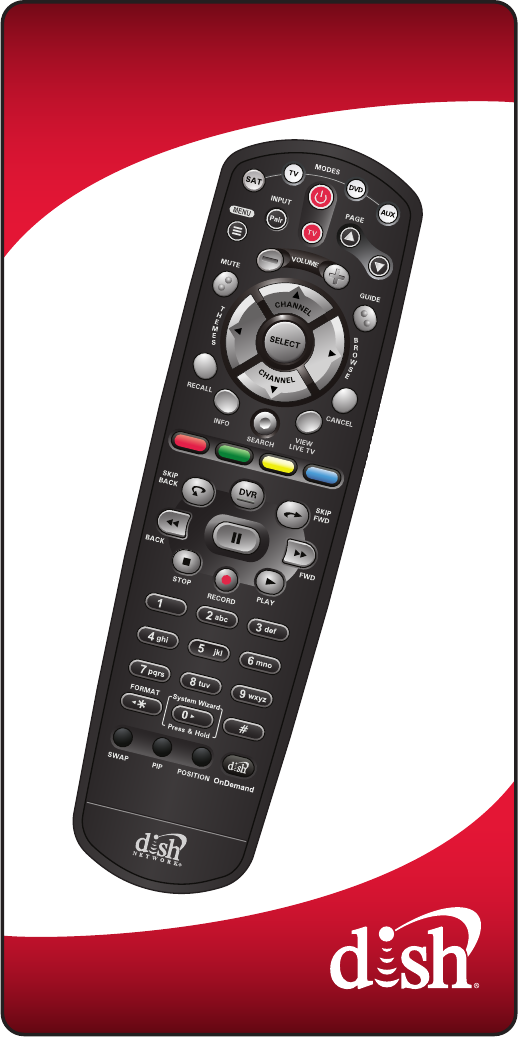
Remote User Guide
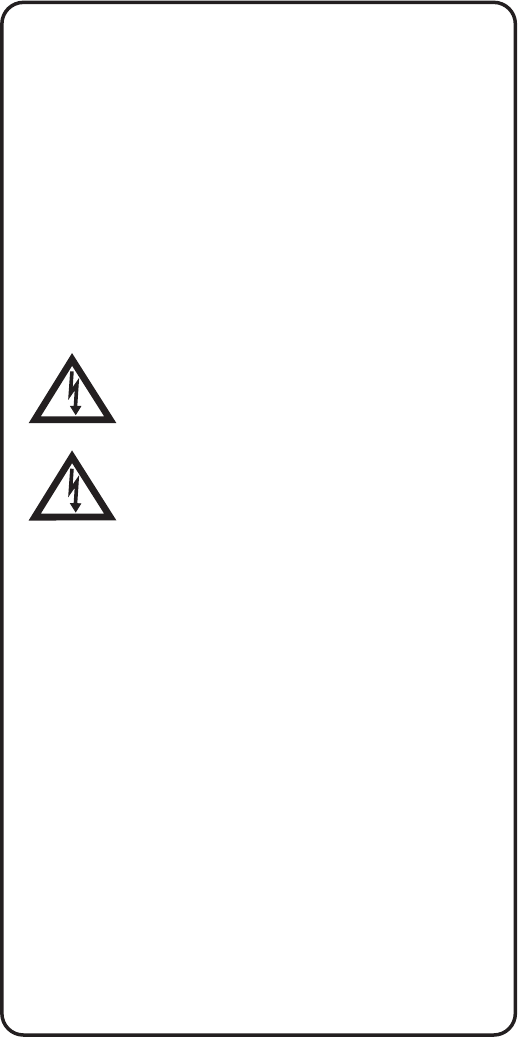
Safety Instructions
You must keep safety in mind while using this device. Keep
these and any other instructions for future reference.
Observe Warnings: Carefully follow all warnings on the device
and in the operating instructions.
Heat: Do NOT place the device near heat sources such as
radiators, stoves, heat registers, or other appliances that
produce heat.
Care and Use
Cleaning: Do NOT use liquid, abrasive, solvent, or aerosol
cleaners. Use a damp cloth for cleaning.
When Not in Use: Remove the batteries if this device is to be
left unattended or unused for a long period of time.
Refer servicing to qualied personnel when a
solid object or liquid has fallen onto or into the
device.
Do NOT attempt to service this device. Refer all
servicing to qualied personnel. Opening covers
other than the battery cover will void the warranty.
Publishing Information
Copyright © 2011. EchoStar Technologies L.L.C., Englewood,
Colorado 80112. All rights reserved.
The information in this User Guide may change without notice.
Revisions may be issued to tell you about such changes.
Send comments or questions about this User Guide to
techpubs@echostar.com or
Technical Publications, EchoStar Technologies L.L.C,
90 Inverness Drive Circle East, Englewood, Colorado 80112.
Document Number: 188891
Printed in
DISH Network is a registered trademark of
DISH Network L.L.C.
All product names, trade names, or corporate names
mentioned in this User Guide are acknowledged to be the
proprietary property of the registered owners.
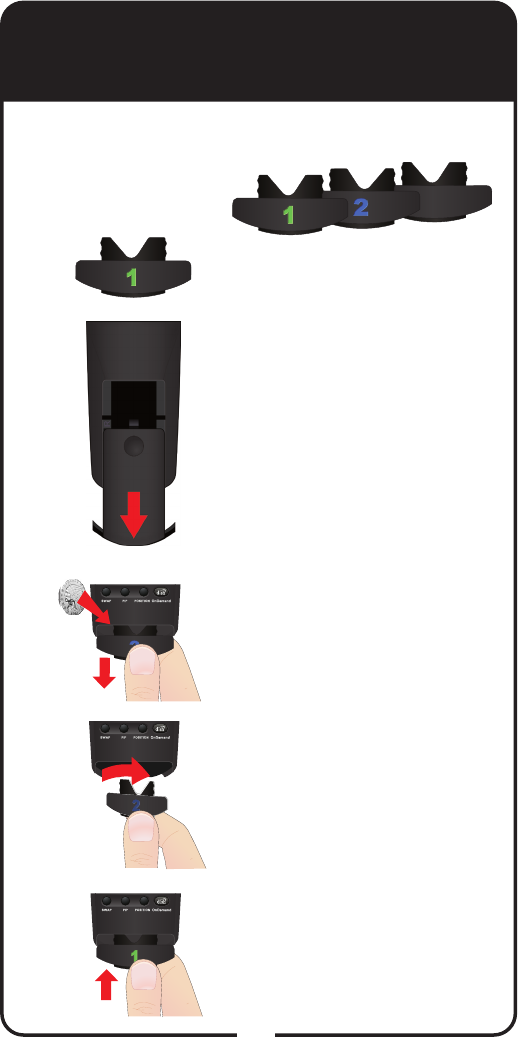
1
Conguring the 40.0 Remote
1
2
3
4
Conrm your remote has the
green number 1 key installed.
Pull the remote battery cover off.
If your remote has a blank,
black key, continue to Insert the
Batteries on page 2.
Separate the key from the
remote by inserting your
thumbnail or a coin in the crease.
Remove the key by grasping at
the bottom.
Insert the key face up and slide
into place.
5
Note: If you are using the green TV1 key that comes
installed in your remote, skip these steps. Go to Insert
the Batteries (page 2).
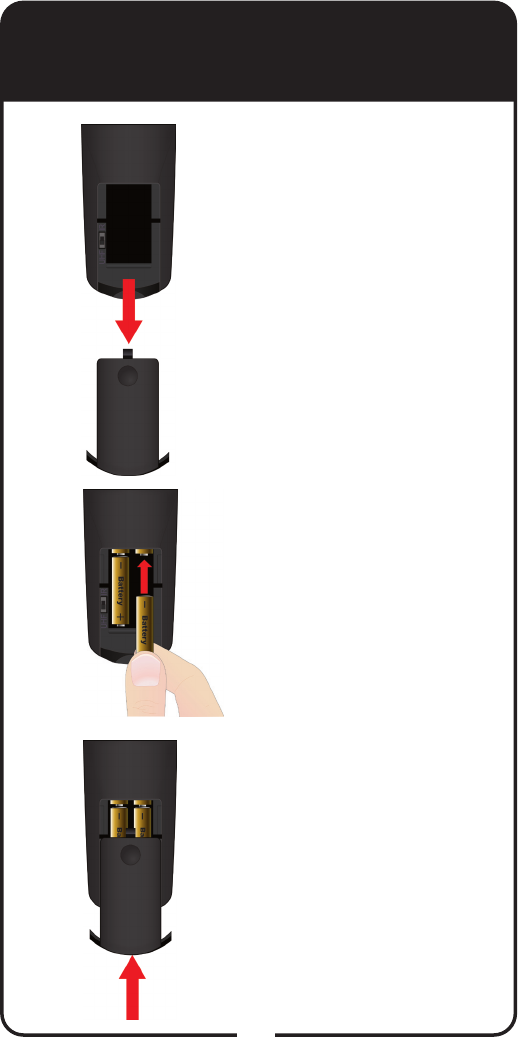
2
Insert the Batteries
Pull the remote battery cover
off.
Insert 4 AAA batteries,
making sure to match the
plus (+) ends with the plus
markings on the battery case.
Replace the remote battery
cover.
1
2
3
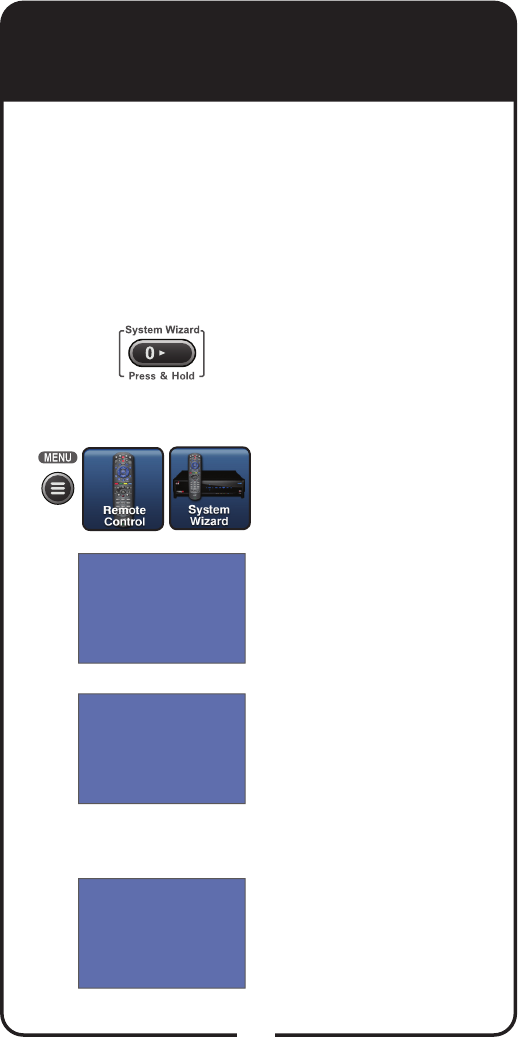
3
Using System Wizard
Use System Wizard initially to set up the remote
to work with the receiver. System Wizard can also
store/restore the settings for your XiP system in both
your remote control’s memory and on the receiver.
This feature is helpful if you ever need to program a
replacement remote or a new system.
Note: If your batteries are low, replace them before
beginning.
Press and hold 0 until
System Wizard message
appears. Make sure the
remote and receiver are in
line of sight.
Or, Press MENU, select
Remote Control, and then
select System Wizard.
If rst time in System
Wizard, follow instructions
provided.
Follow the on-screen
options to Backup or
Restore setting for your
XiP system and remote
control settings.
Select Continue to return
to your paid programming.
1
2
3
4
OR
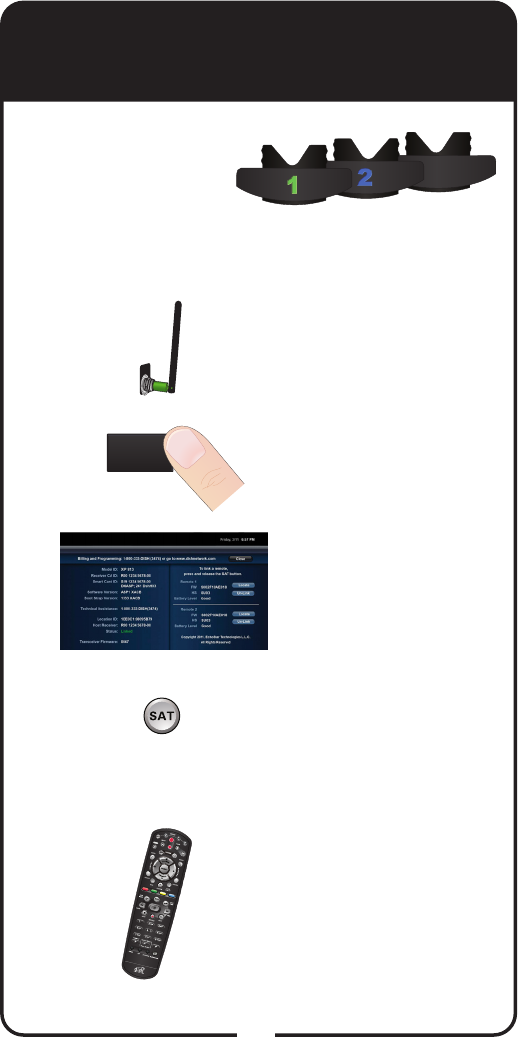
4
Linking Remote to Receiver
Verify the antenna
is installed on the back
of the receiver.
Turn your receiver and
TV on, and press
SYSTEM INFO on the
front panel of the receiver.
Conrm that you
see the System
Info screen.
Press and release SAT
on your remote. Wait until
you hear a tone and see
the remote listed on the
screen.
Conrm that your remote
operates your receiver by
pressing remote buttons.
If this is not working, go
back to step 4.
3
2
1
4
5
Use these instructions
to link the remote
to the receiver if
your receiver does
not support System
Wizard.
REMOTE
ANTENNA
SYSTEM
INFO
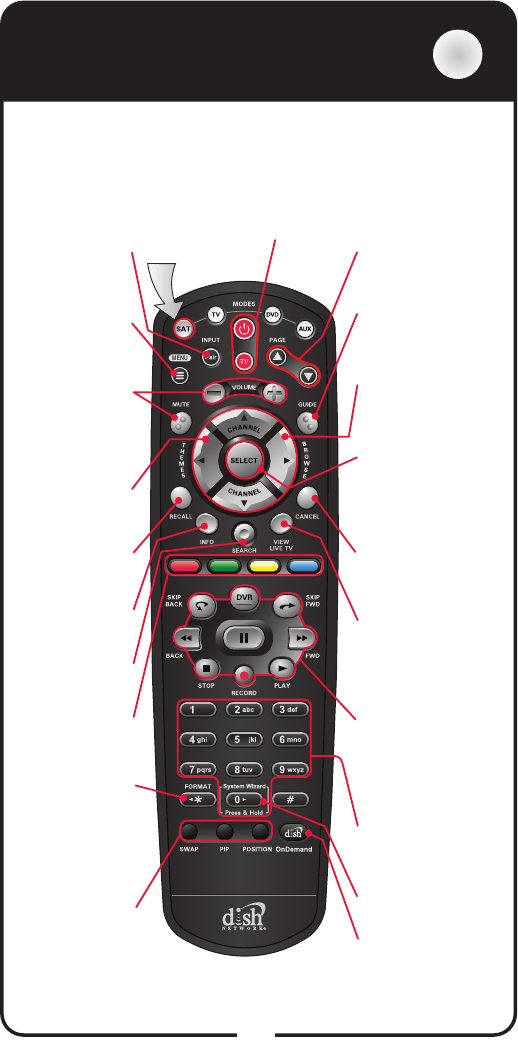
5
SAT Mode
To use the features described in this section, make sure you
are in SAT mode by pressing the SAT Mode button.
Note: Some features may not be available depending on your
receiver model.
SAT
Power & TV Power
Top button turns the receiver on/off
Bottom button turns the TV on/off
Volume and
Mute Buttons
Control TV
volume
Programming
required
Recall
Return to last TV
channel viewed
Picture-In-
Picture (PIP)
Buttons
Watch two
separate
programs at
same time (in
Single Mode)
Number Buttons
Enter a channel
number or navigate
through menus
Menu
Access receiver
features and
settings
Pair/Input
Press once for
Input. Press and
hold for Pair
Themes
Search for
programs
using Themes
Info
Retrieve info
on programs
Search
Search for a
program
Shortcut Keys
Access
frequently
used features
Digital Video
Recorder (DVR)
Buttons
Pause live TV and
play or record
programming
Format
Format the
picture to the
desired width
to match the
program you
are viewing
System Wizard
Press and hold to
x remote control
issues and sync
data
Arrow/Select
Buttons
Channel up/down,
navigate through
menus, and select
a desired option
View Satellite
Programming
Exit out of any
menu/guide and
return to viewing
live TV
Cancel
Return to previous
menu or to watch
a program
Browse
See what is on
other channels
while watching TV
Program Guide
Display current
and future satellite
program listings
Page Buttons
Page up/down
in menus
Press this
button for
SAT Mode
Dish OnDemand
Explore interactive
TV features
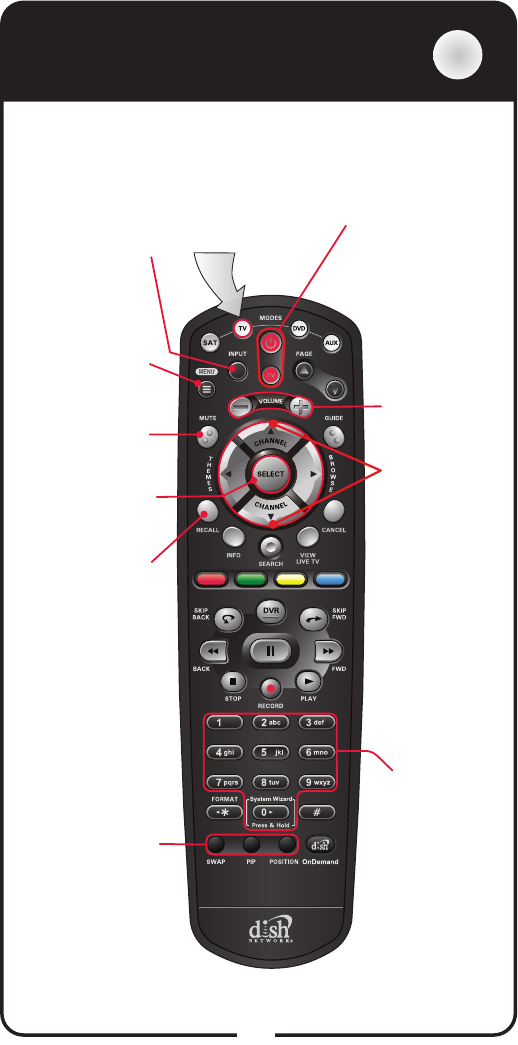
6
TV Mode TV
To use the features described in this section, make sure
you are in TV mode by pressing the TV Mode button.
Remote programming is required. Note: Some features
may not be available depending on your receiver model.
Note: Remote operation is different on DISH Network TVs.
See your DISH Network TV User’s Guide for proper operation.
Power & TV Power
Top button turns
the TV on/off
Bottom button
turns the TV on/off
Press this button
for TV Mode
Mute
Turn TV volume
on or off
Recall
Return to last TV
channel viewed
Picture-In-Picture
(PIP) Buttons
Watch two separate
programs at same
time (in Single
Mode)
Number
Buttons
Enter a channel
number or
navigate
through menus
TV Menu
Access menu
features available
on some TVs
Pair/Input
Switch between
TV inputs
(available only for
certain makes and
models of TVs)
Up/Down
Arrow Button
Channel up/
down on the TV
Volume
Control TV
volume
Select Button
Select a program
or menu
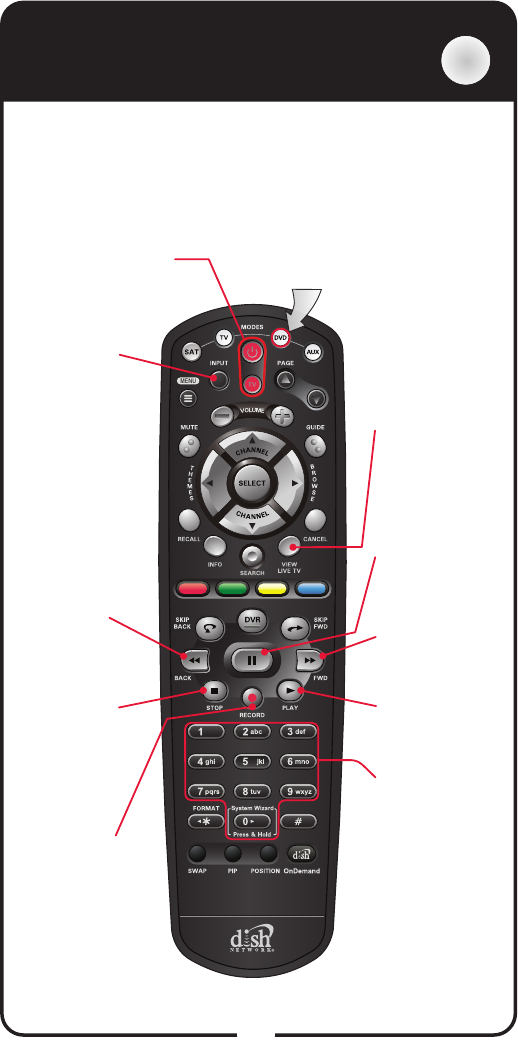
7
DVD Mode DVD
Power & TV Power
Top button turns the
DVD/VCR/BD on/off
Bottom button
turns the TV on/off
Number Buttons
Enter a channel
number or
navigate through
menus
Pair/Input
Press once
for Input
Press and
hold for Pair View Satellite
Programming
Exit out of any
menu/guide
and return to
viewing live TV
Press this button
for DVD Mode
FWD
Forward a
videotape or
DVD
Play
Play a videotape
or DVD
Pause
Pause a
videotape or
DVD
Back
Rewind a
videotape
or reverse a
DVD
Stop
Stop playing
a DVD, stop
playing or
recording a
videotape
Record
Record on a
videotape
To use the features described in this section, make sure you
are in DVD mode by pressing the DVD Mode button. You
can use this mode to operate a Blu-ray disc player or VCR.
Remote programming is required. Note: Some features
may not be available depending on your receiver model.
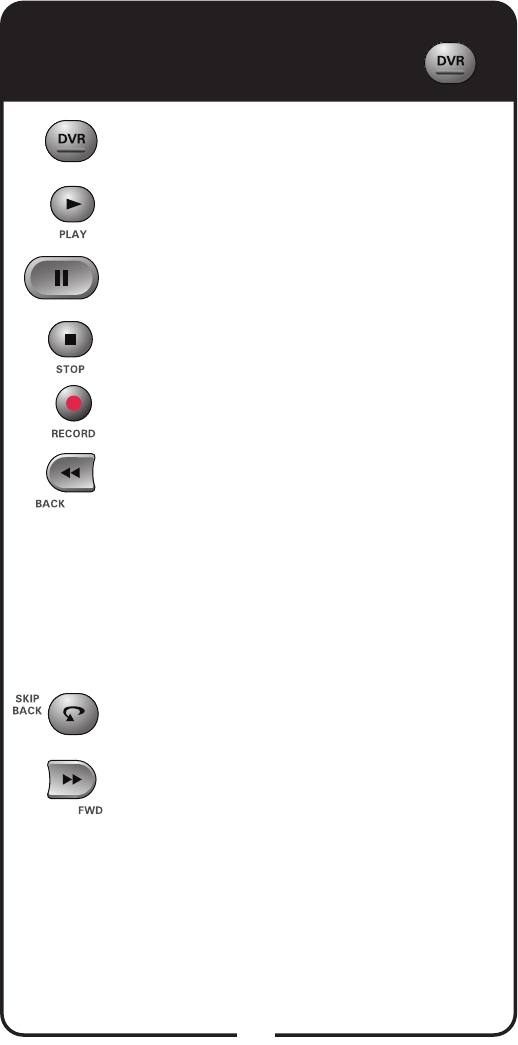
8
DVR Functions
• Press twice to go to the list of recorded
programs.
• Plays a live or recorded program.
• Pauses a live or recorded program.
• Stops recording a program.
• Records a program.
• Press BACK once to reverse the program
four times as fast as normal play. Press
BACK twice to reverse at 15 times normal
speed, three times to reverse at 60 times
normal speed, and four times to reverse
at 300 times normal speed. The on-
screen bar shows how far you’ve gone.
For a live program, you can only reverse
back to the last channel change or back
one hour, whichever occurs rst.
• Press SKIP BACK to skip back about 10
seconds in a program.
• Press FWD (Forward) once to fast-
forward through the program four times
normal speed. Press FWD twice to
forward at 15 times normal speed, three
times to forward at 60 times normal
speed, and four times to forward at 300
times normal speed. The on-screen bar
shows how far you’ve gone. Of course,
you cannot forward into the part of a
live program that has not been broadcast.
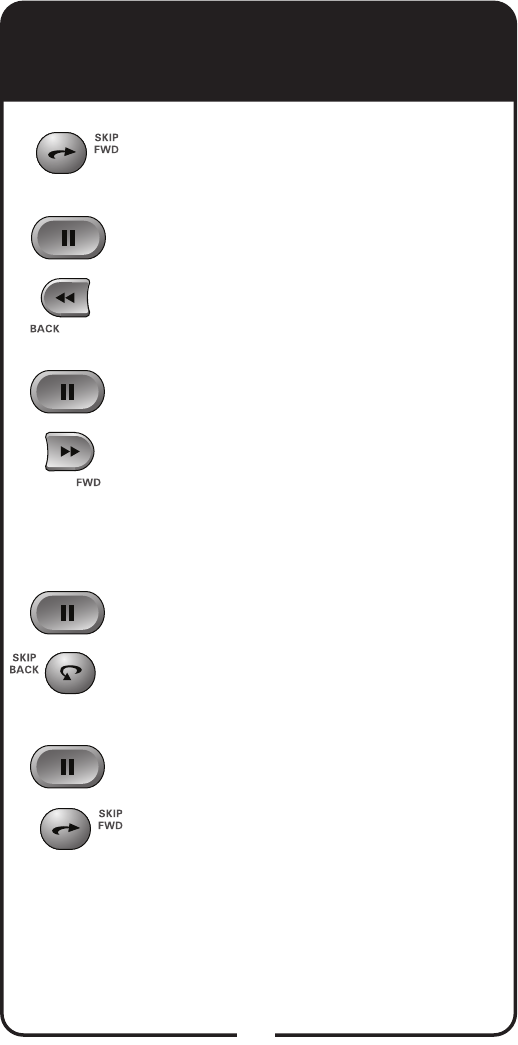
9
DVR Functions, continued
• Press SKIP FWD to skip ahead about
30 seconds in the program.
• Press PAUSE and then press BACK
to reverse the program in slow motion
at 1/4 the speed of normal play. Press
BACK again to reverse at normal
speed.
• Press PAUSE and then press FWD to
forward the program in slow motion at
1/15 the speed of normal play. Press
FWD twice to forward at 1/4 as fast
as normal play. Press FWD three
times to play the program. Of course,
you cannot forward a live program that
has not been broadcast yet.
• Press PAUSE and then press SKIP
BACK to reverse the recording frame-
by-frame.
• Press PAUSE and then press SKIP
FWD to advance the recording frame-
by-frame.
+
+
+
+
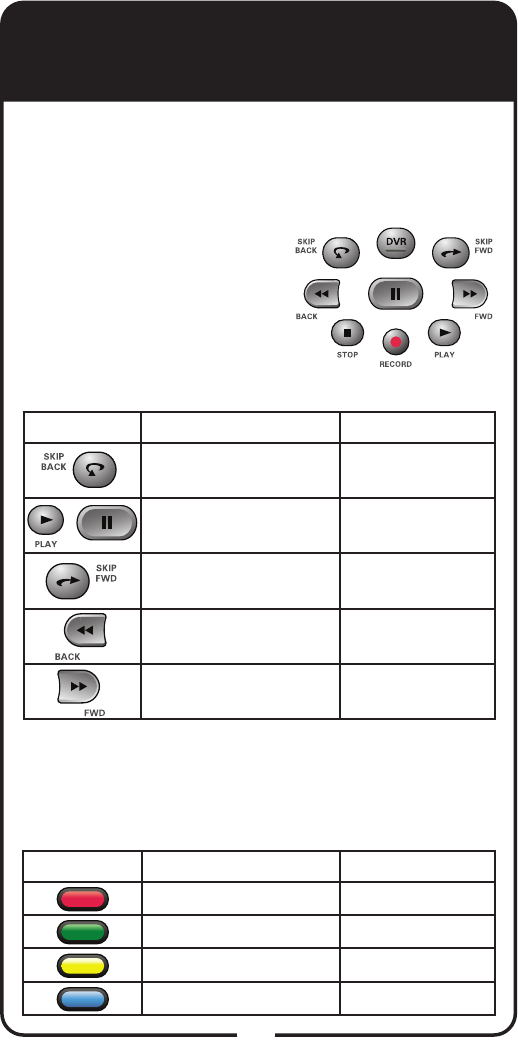
10
Using Remote Button
Shortcuts
In addition to their normal functions, some buttons
on your remote control have special shortcut
functions when you are navigating the on-screen
Electronic Program Guide (EPG), or inside a drop-
down menu of options or scrollable list of events
displayed by your receiver.
DVR Buttons
The following table lists some
of these shortcuts for the gray
set of buttons that normally
control your DVR functions.
Note: Scheduled updates to your receiver software
may add to or modify these shortcuts.
Buttons In Guide Display Scroll in Lists
Move 3 hours back By 1 screen
upward
Watch highlighted show No
Move 3 hours ahead By 1 screen
downward
24 hours back To beginning of list
24 hours ahead To end of list
Buttons From Live TV Scroll in Lists
Jumps to menu bar Jumps to menu bar
Access Quick Clicks list No
Access Setting screen No
Access Broadband Setup No
Colored Buttons
The following table lists some of the shortcuts for
the colored set of buttons on your remote control.
Note: Scheduled updates to your receiver software
may add to or modify these shortcuts.
+
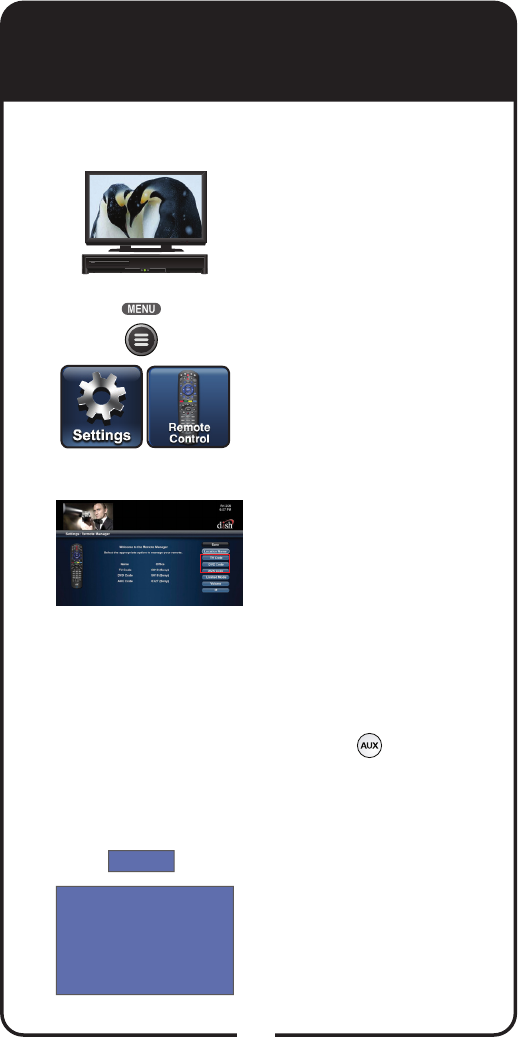
11
Programming Remote to
Control Another Device
Entering a Code
Turn the device and
receiver on.
Press MENU and select
the Settings tile. From the
Settings screen, select
Remote Control.
Select the TV Code, DVD
Code, or AUX Code
option on the Remote
Control settings screen. If
programming in TV Code or
DVD Code, continue to
Step 4. If programming in
AUX Code, continue with
this step.
For programming in
AUX Mode only:
Scroll the Aux Device: list
to select and highlight your
device type. Select Next.
Select Enter Code.
Using the on-screen
keypad, enter the four-digit
code for your device.
Select Continue.
3
2
1
4
5
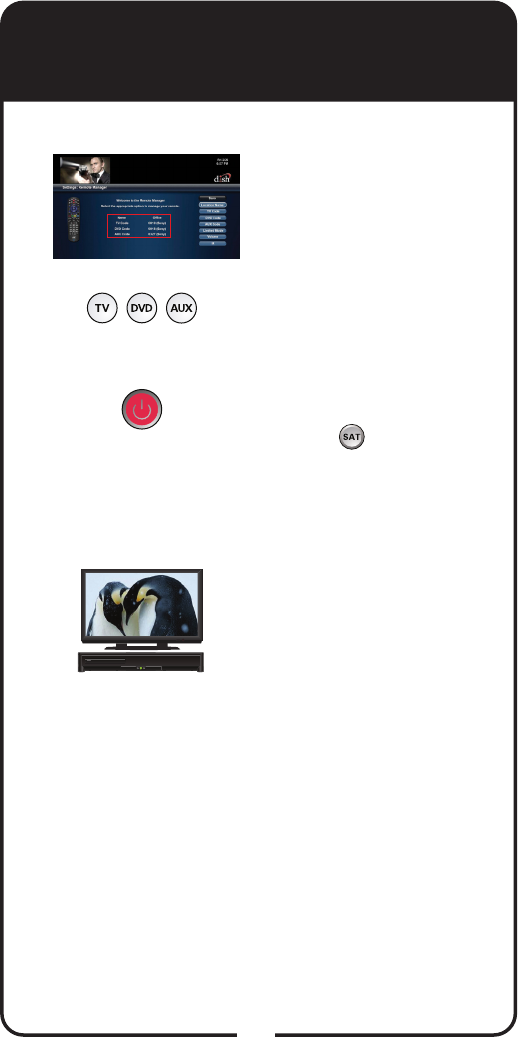
12
Entering a Code, continued
7
6
5
8
Conrm that the code you
entered appears for the
programmed device (TV,
DVD, or AUX) on the Remote
Control settings screen.
Press the Mode button for the
device you are programming
(TV, DVD, or AUX). Release.
Press POWER.
If device does not turn off,
press SAT to switch
modes and release. Try
entering the code again. If
device turns off, continue to
step 10.
Using remote, turn the device
back on and try some other
remote buttons to see if they
work.
Repeat steps 1 through 10
until you have the best code
for controlling your device.
Programming Remote to
Control Another Device, con’t.
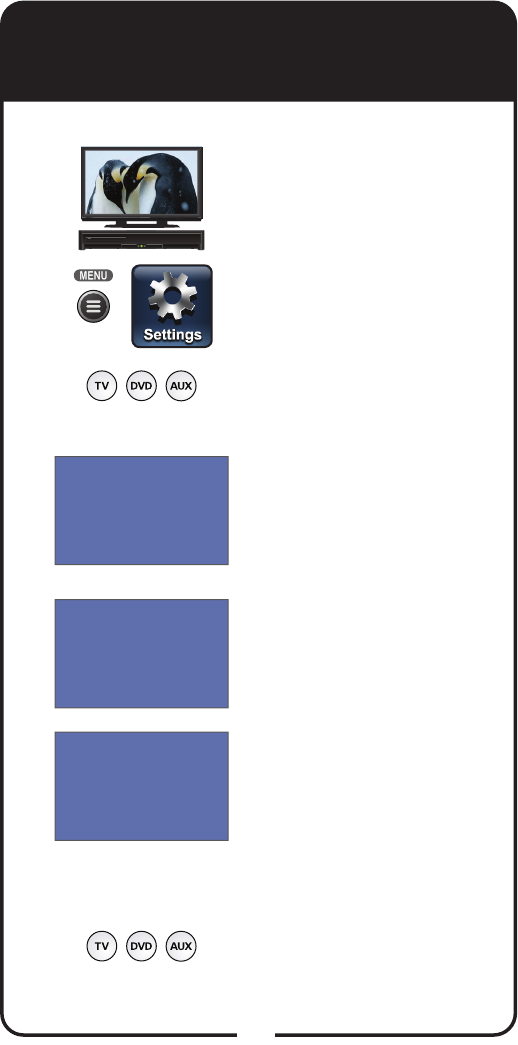
13
Programming Remote to
Control Another Device, con’t.
Scanning the Remote Database
Turn the device and
receiver on.
Press MENU and select
Settings tile. From the
Settings screen, select
Remote Control.
Select either TV Code, DVD
Code, or AUX Code option,
as applicable.
Select the Look Up Code
option. Note: The three-digit
device codes used by other
DISH Network remote controls
cannot be used.
Scroll the Sort By: (or Aux
Device:) list to position the
selected option within the blue
highlight bar.
Highlight device’s name in the
Brand: list and select Next.
Note: If the brand is not listed,
see Entering a Code on
page 11. The available device
codes and the code ready
to be tested displays for the
selected brand.
Press the Mode button for
the device you are setting up.
Release.
1
2
3
4
5
6
7
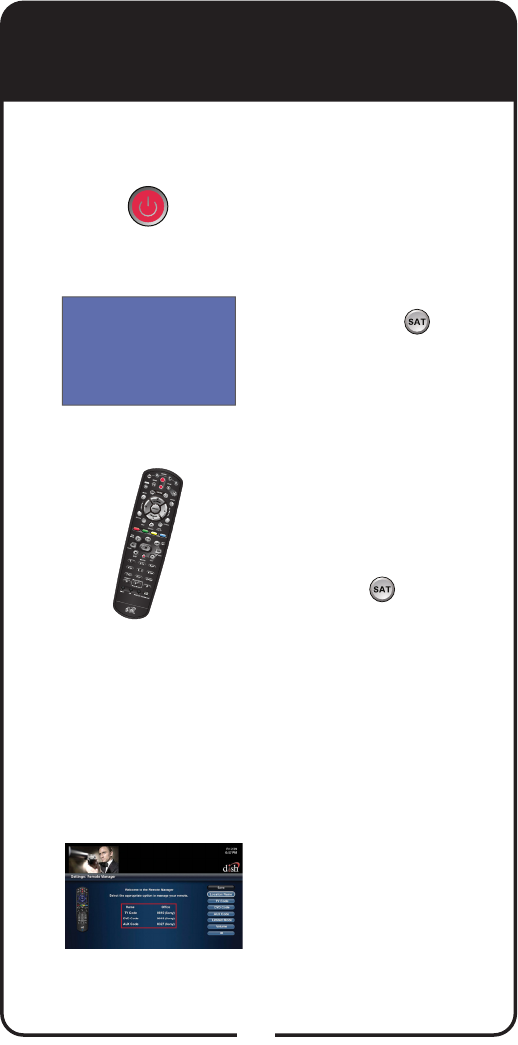
14
Press POWER to turn off
your device. If device turns
off, continue with step 9.
If it does not turn off, press
and release SAT to
switch modes. Select No
on screen and repeat steps
7 and 8 for the next code.
Using the remote, turn the
device on and try some
other remote buttons to
make sure they work.
When nished, press and
release SAT to switch
modes.
If the code worked for
other buttons, select Yes
and continue to step 11.
If the code did not work,
select No and repeat steps
6 through 9 for the next
code for the brand of your
device.
On the Home screen,
conrm that the device’s
brand name is in
parentheses after a four-
digit code.
Programming Remote to
Control Another Device, con’t.
Scanning the Remote Database,
continued
8
9
10
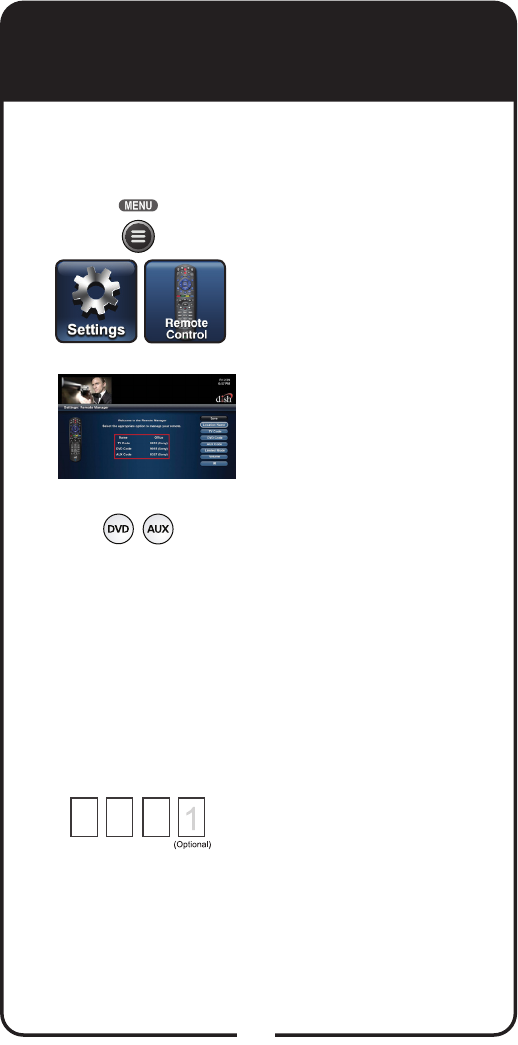
15
Displaying Device Code
and Remote Address
To identify the device code that your remote control
is using or the address that your remote control is
using, complete the following steps:
Press MENU, select Settings
tile, and then select Remote
Control. The Home screen
for your current remote
control displays.
Verify that the brand name
of TV shown in parentheses
after the code matches the
brand name of your TV.
For DVD and AUX modes,
the codes should be
accompanied by the brand
name of your equipment in
parentheses. Remember that
the type of device controlled
in DVD mode may be either
a DVD/BD player or a VCR,
and AUX also may be an
audio receiver, accessory,
amplier, or a second TV.
Record the stored device
code in the Reference Table
on the inside back cover of
this Guide.
3
2
1
4
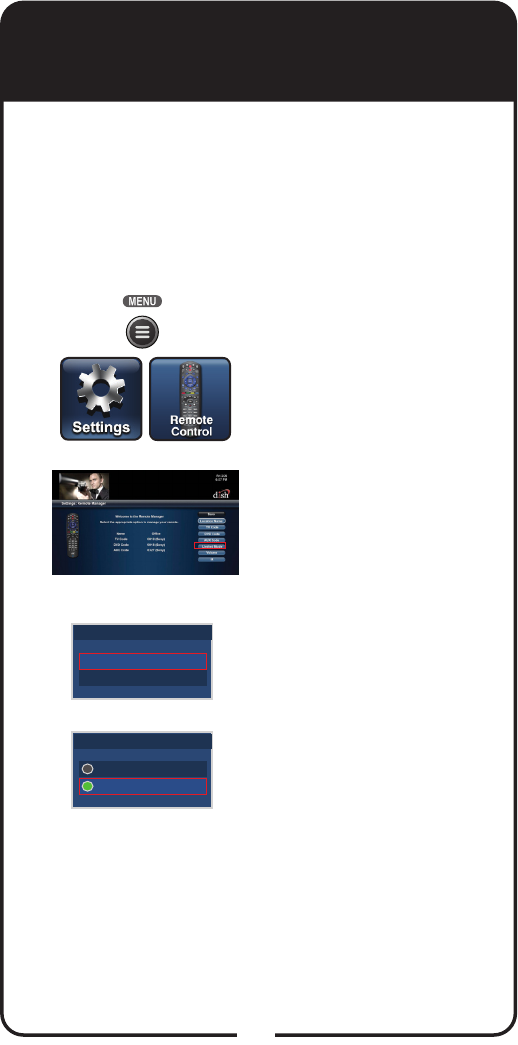
16
Placing Remote in Limited
Mode
Limited Mode locks out all the device mode
operations except for the device’s power, Mute, and
Volume. This prevents you from accidentally tuning
away from satellite programming.
Note: Limited Mode cannot be used with audio
ampliers.
Press MENU, select
Settings tile, and then
select Remote Control.
Select the Limited Mode
option.
Use the arrow button to
highlight Enabled and
then select it. Highlight and
select Save.
To take the remote out of
Limited Mode, highlight
Disabled instead of
Enabled in step 3.
1
2
3Enabled
Disabled
Limited Mode
Enabled
Disabled
Limited Mode
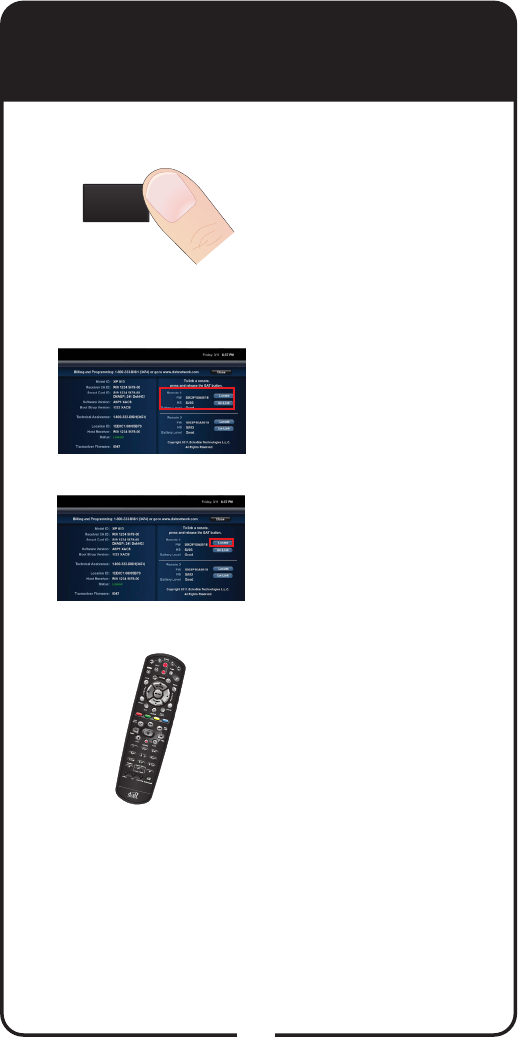
17
Locating a Lost Remote
Activate your receiver’s
front panel controls and
touch LOCATE REMOTE.
Find the remote that you
are looking for in the list of
remotes on the right-hand
side of the screen.
Select the Locate option
next to the remote you want
to nd.
If the missing remote control
is linked to this receiver
and within RF range, there
should be a series of tones
you can hear to help you
nd the location of the
remote. Press any button
to turn off the Locate tones
after nding the remote.
If the remote control you
want to nd is not listed, it
is not linked to the receiver
or is out of RF range;
therefore, Locate isn’t an
option.
1
2
3
4
The next time you misplace the remote control or
wonder where one is, try the Locate feature.
LOCATE
REMOTE
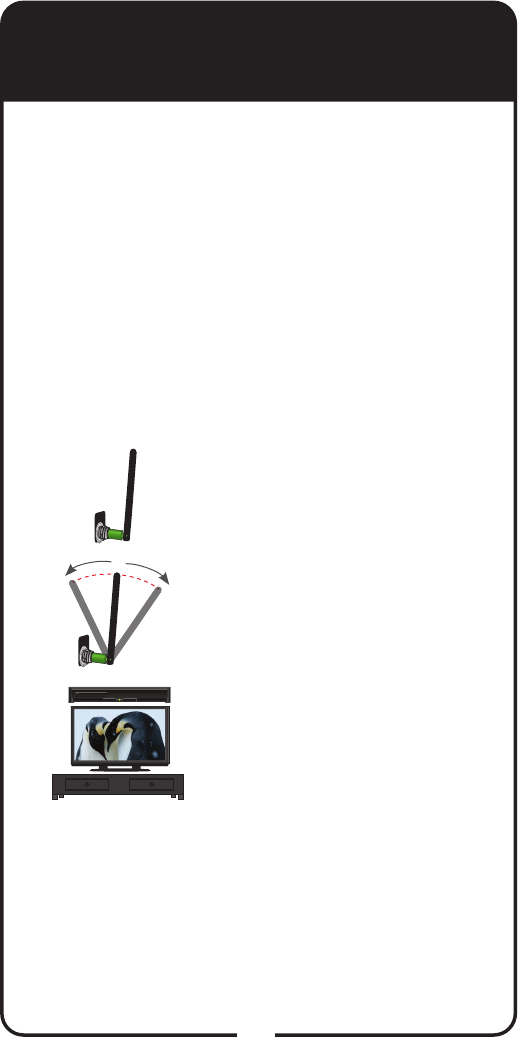
18
Avoiding RF Interference
Because your remote control uses UHF-2G radio
frequencies, you might experience interference
from certain other devices transmitting nearby. The
instructions in this section describe how to avoid such
conicts.
Ensure the UHF-2G remote
antenna is connected to the correct
input on the receiver’s back panel
and is not touching anything.
Tighten only by hand.
Vary the tilt angle of the receiver’s
remote antenna, locating the
antenna’s tip away from any other
electronic equipment or metal
surfaces, even if separated by
wooden shelving.
Move the receiver to a different
location. Place the receiver on
as high a surface as possible,
above all other equipment in your
entertainment center.
Use the optionally available special
cable to connect the remote
antenna to the receiver and place it
away from other equipment.
Move any nearby antenna or radio
equipment away from the UHF-
2G remote antenna. Do not place
an over-the-air antenna, WiFi,
Bluetooth, or Zigbee devices on or
near the remote antenna.
2
3
4
Adjusting the Antenna
Your receiver links to and communicates with its
remote control(s) through a special antenna connected
to the Remote Antenna input on the receiver’s back
panel.
Note: This special remote antenna cannot be used
with any other DISH Network satellite receivers or their
remotes. Conversely, remote antennas used with other
DISH Network satellite receivers and remotes cannot
be used with your XiP receiver or remote controls.
REMOTE
ANTENNA
1
5
REMOTE
ANTENNA
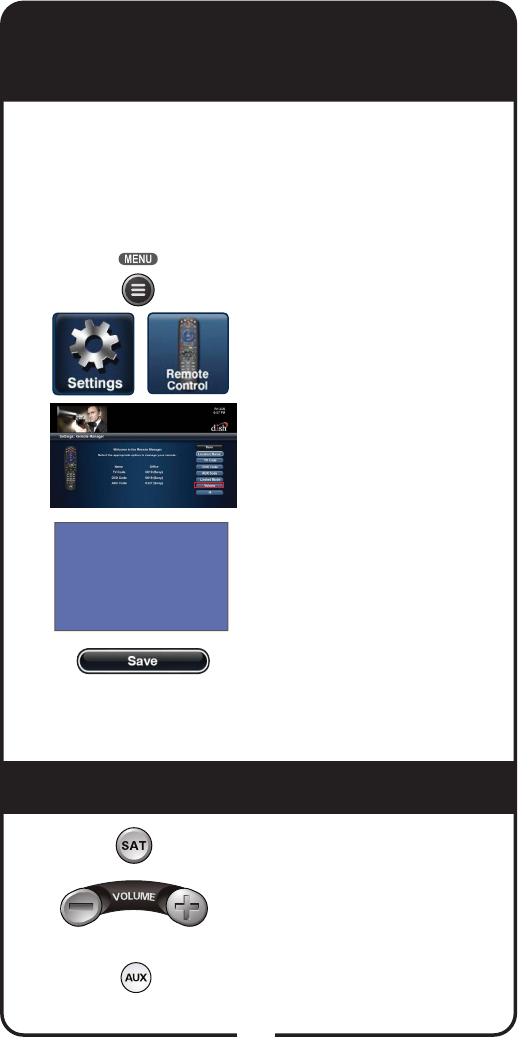
19
Control Amplier Volume
When the remote control is set up to operate your
TV, the MUTE and VOLUME buttons adjust your
TV volume when in SAT mode. To use the remote
to adjust the volume of a remote-controllable audio
receiver or amplier instead of adjusting the TV’s
volume setting, use the steps on this page.
Press MENU, select
Settings tile, and then
select Remote Control.
Select Volume.
Under Control Volume
For: use the down arrow
key to highlight the AUX
option.
Highlight and select the on-
screen option to Save this
setting.
1
2
3
4
5
6
7
Make sure the remote controls the amplier’s
volume in other modes:
Press SAT.
Press the plus (+) and
minus (-) sides of the
VOLUME button.
Your tuner/amplier’s volume
changes, and the AUX mode
button lights.
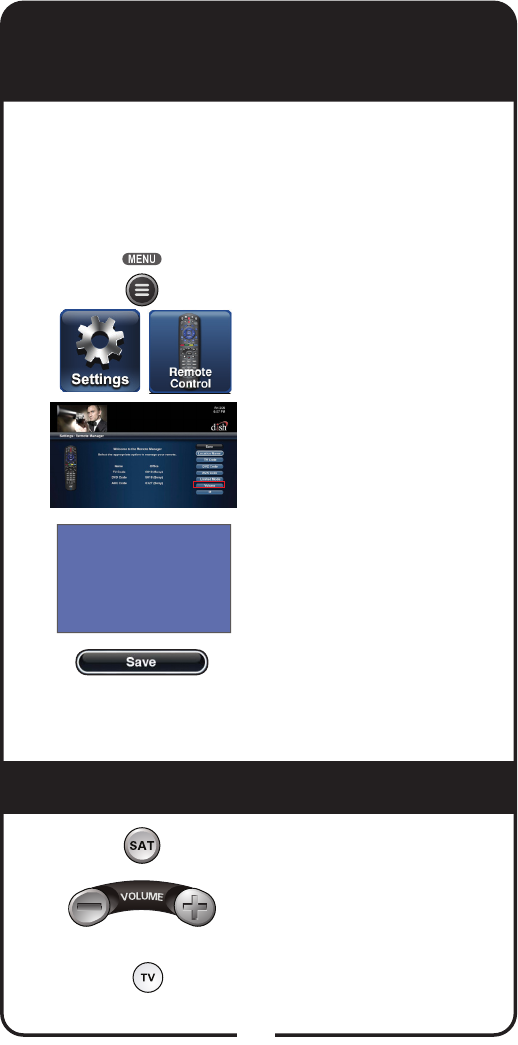
20
Control TV Volume
Use this procedure to change from having the remote
adjust the volume of an audio receiver or amplier to
having the remote adjust the TV’s volume. When the
remote control is set up to operate your TV, the MUTE
and VOLUME buttons adjust your TV volume when in
SAT mode.
Press MENU, select Settings
tile, and then select Remote
Control.
Select Volume.
Under Control Volume for:
use the up arrow key to
highlight the TV option.
Highlight and select the on-
screen option to Save this
setting.
1
2
3
4
5
6
7
Make sure the remote controls the TV’s
volume in other modes:
Press SAT.
Press the plus (+) and minus
(-) sides of the VOLUME
button.
Your TV’s volume changes,
and the TV mode button lights.
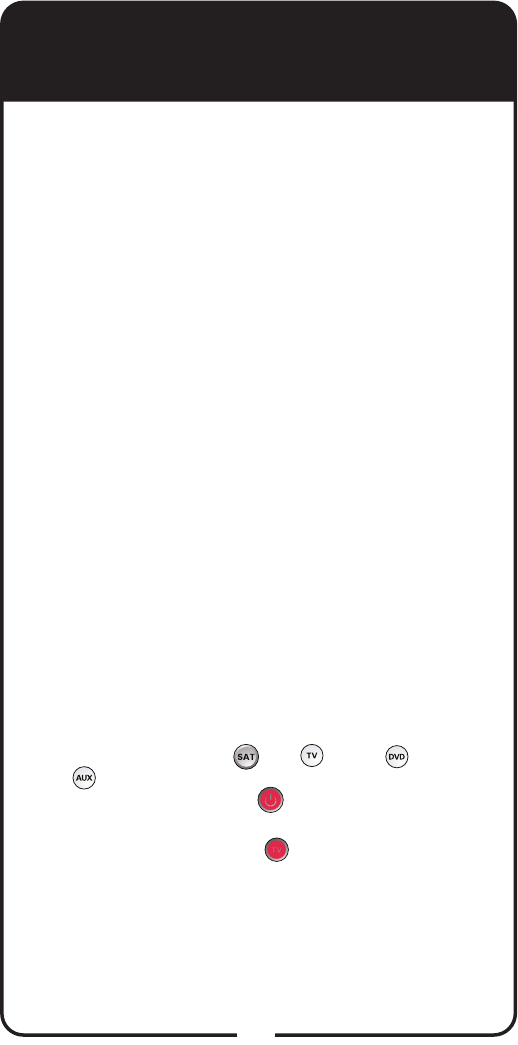
21
Learning From Another
Device’s Remote
Use this procedure if you are unable to nd a code
that allows your DISH Network remote to control your
device or if some of the commands are not functioning
as you expect after programming your DISH Network
remote to control your device (in TV, DVD, or AUX
modes). Use this procedure to have your DISH
Network remote learn the commands of the other
device’s remote control.
The remote control can learn commands in one of two
ways:
• You can follow the instructions for using device
codes to program a specic mode, and then
learn commands that add new or overwrite
existing functions of the remote control’s buttons
in this mode. For this type of learning, any
button without a learned command keeps the
previous command (if any) for that device code.
To program a specic mode, use the instructions
for Entering a Code on page 11 or Scanning the
Remote Database on page 13.
or
• Each button on this remote learns a command
from the device’s original remote control. For this
type of learning, any button without a learned
command keeps the previous command (if any)
for that device code.
Learning can occur only in TV, DVD, or AUX modes.
The Mode buttons (SAT , TV , DVD , and
AUX ) cannot learn a command. For each Mode
button, the POWER button can be learned to turn
the devices associated with that Mode on and off.
Note: The TV Power button turns the TV on and off
in all Modes. It cannot be learned.
Note: The remote times out if a button isn’t pressed
within 20 seconds. If the remote times out, then the
learning process needs to start over again.
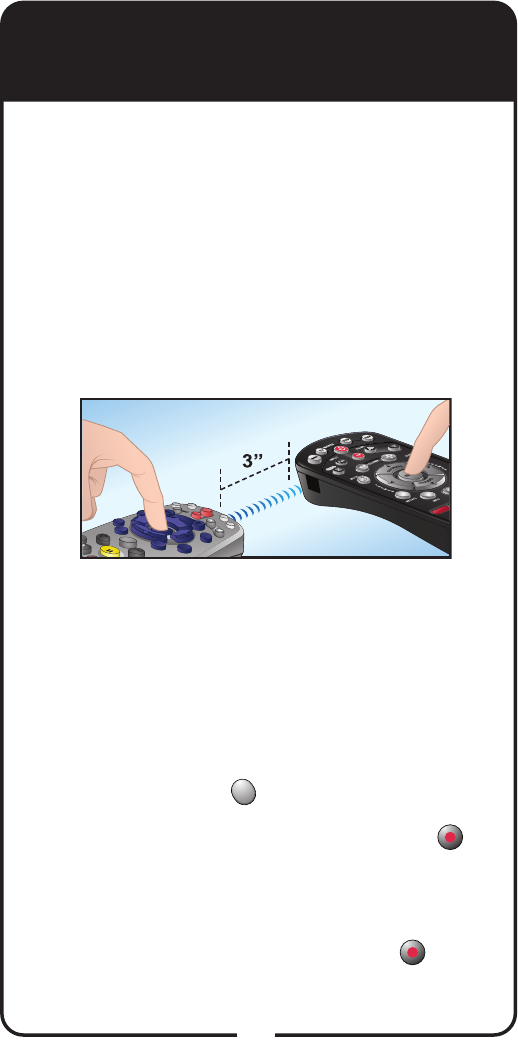
22
To have the DISH Network remote control learn specic
commands for another device, complete the following
steps.
Ensure the DISH Network remote control is working
with the receiver (see page 4).
Place both the DISH Network remote and the
original device’s remote control on a at, stable
surface. Point the front of the original device’s
remote to face the small square (IR window) on the
front, left-hand side of the DISH Network remote, as
shown below. The remotes should be no more than
3” apart.
On the DISH Network remote, press and hold the
Mode button you want to use for the device until
all the Mode buttons light up (approximately three
seconds), and then release it. The selected Mode
button blinks continuously.
To start learning commands for this mode, select
one of the following choices:
• If you’ve found a code for the device and
programmed it into the remote, press and
release RECALL (the Mode light goes off
when RECALL is pressed and comes on when
released), then hold the RECORD button until
the Mode button is lit again (about three seconds).
The Mode button remains lit while learning.
• If the device code has not been programmed for
that device or if you are unable to nd a code,
press and hold the RECORD button until
the Mode button is lit (about three seconds). The
button remains lit while learning.
Learning from Another
Device’s Remote, continued
3
4
2
1
SAT
POWER
I
MENU
GUIDE
B
R
O
W
S
E
T
H
E
M
E
S
MUTE
RECALL
SKIP
BACK
P
A
VOLUME
DVR
TV
VCR
AUX
TV
PAGE
CANCEL
INFO
VIEW TV
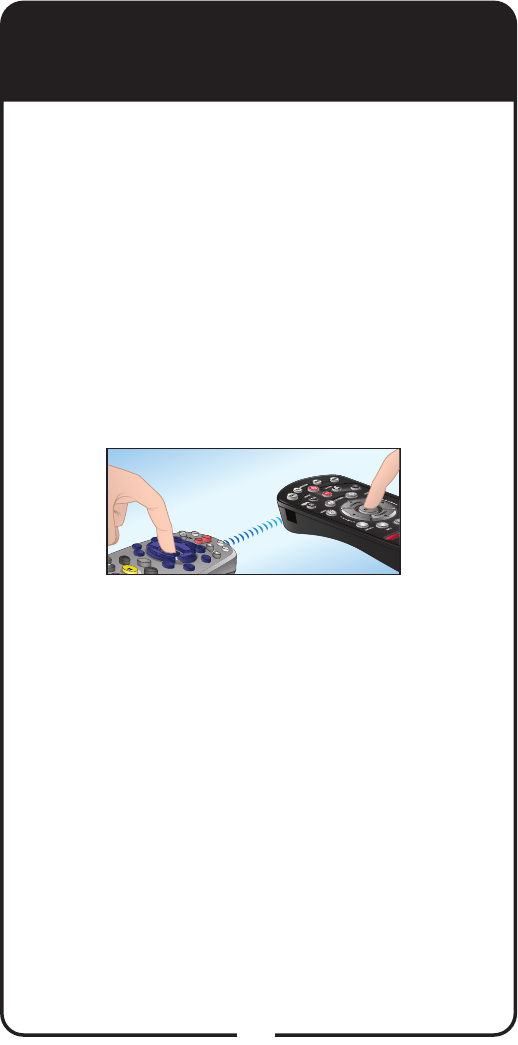
23
Learning from Another
Device’s Remote, continued
On the DISH Network remote, press and release
the button you want the DISH Network remote to
learn from the original device’s remote. The Mode
light goes off and comes back on.
On the original device’s remote control, press and
hold the button you want learned until the Mode
light goes out and comes back on. You may need
to press and hold the button on the original remote
several times before the DISH Network remote
learns the command.
• If the DISH Network remote learns the command,
the Mode light blinks off and then back on.
• If the Mode light blinks three times or remains
lit, the DISH Network remote did not learn the
command.
After a button has learned a command successfully,
repeat step 5 and step 6 until all commands you
want have been learned.
Press and release one of the Mode buttons on the
DISH Network remote to end the learning sequence.
This saves all the commands for that mode and exits
learning to return to normal remote control operation.
To cancel learning, do not press any buttons on
either remote control for at least 20 seconds. The
DISH Network remote control times out and returns
to normal operation.
Note: If the remote control batteries are too low
for learning, all the Mode buttons blink quickly
eight times. Learning ends without saving learned
commands, and the remote returns to normal
operation. Change the batteries and begin learning
again.
Note: No learned commands are saved if the DISH
Network remote control times out before completion.
7
6
8
5
SAT
POWER
I
MENU
GUIDE
B
R
O
W
S
E
T
H
E
M
E
S
MUTE
RECALL
SKIP
BACK
PA
VOLUME
DVR
TV
VCR
AUX
TV
PAGE
CANCE
L
INFO
VIEW TV
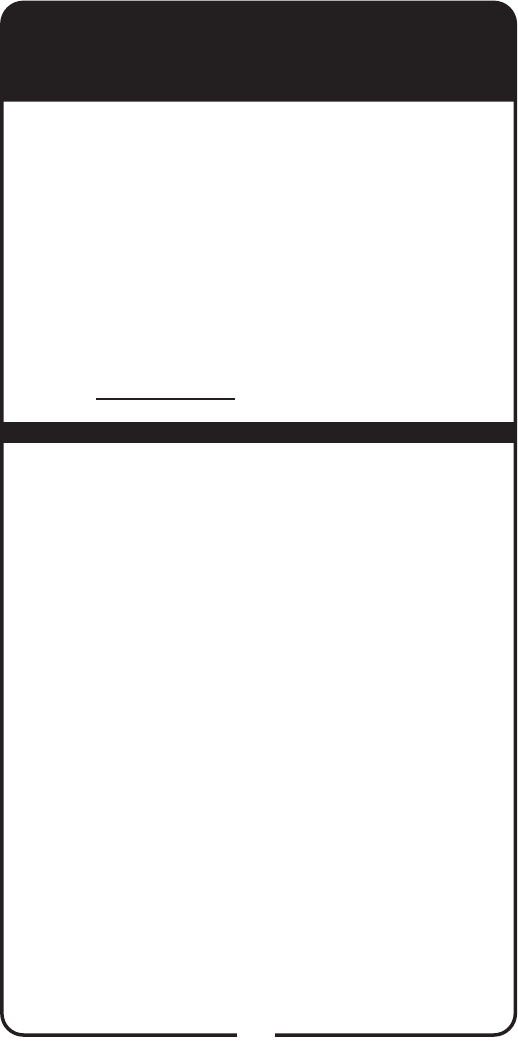
24
Troubleshooting
Use this information if you have a problem using
the remote. To solve a particular problem, do the
following:
• Find the information that relates to the problem
you are experiencing. Try the suggested solution
for that problem.
• Make sure your remote control has fresh
batteries. If you see the Remote Battery Low
warning on your TV screen, it is time to change
the batteries. Follow the instructions on page 2.
• Make sure you have a direct line of sight between
the remote and the receiver.
• Visit www.dish.com.
While performing a remote control procedure, the
remote control stops working.
What to do: Start over again. If you don’t press a
button for 20 seconds in a programming sequence,
the remote shuts off its programming function.
When you press a button on the remote control,
the equipment doesn’t do what you expect.
What to do: Press the correct mode button to set
the remote to the mode for the device you want to
control: SAT for your receiver, TV for your TV, DVD for
you disc player/VCR, or BD, or AUX for your auxiliary
equipment. Point the remote control directly at the TV,
with no objects blocking the signal path. The remote
control uses IR signals to control the devices. IR
signals travel less than 40 feet, and cannot go through
walls or other solid objects.
If the batteries are missing or dead, replace them
with new AAA-size batteries. If the remote has new
batteries, check whether you put them in correctly.
If you didn’t, take them out and put them in the right
way.
Set up the remote to control all the devices you want
to use with the remote. See Programming Remote to
Control Another Device on page 11.
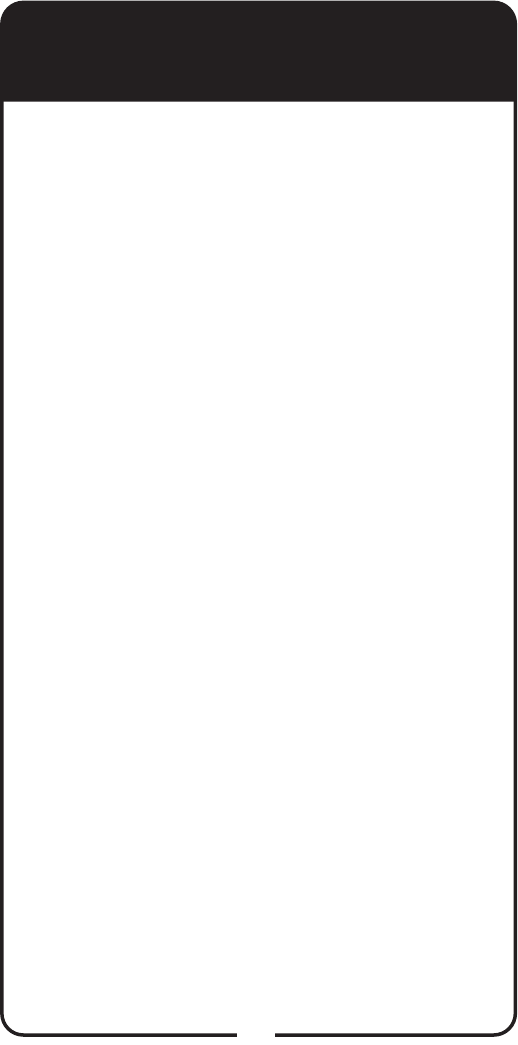
25
Troubleshooting, continued
When you try to enter TV programming mode, all
the mode LEDs ash.
What to do: Replace the batteries (see page 2).
Your remote control does not work well.
What to do: Move your receiver to different
locations. For best results, place the receiver as
high as possible, above all other equipment in your
entertainment center. There may be IR interference
from objects near the receiver.
Your remote control seems to have stopped
working.
What to do: Press one or more buttons on the
remote to wake the remote control. The remote
control may have gone to sleep to reduce battery
drain. If your remote is still unresponsive, take out
the batteries and press any button for three seconds,
then reinsert the batteries.
Your picture is snowy (or black or blue).
What to do: Make sure your TV is tuned to the
correct channel. You may have accidentally changed
the channel on your TV. Check the Reference Table
to see what channel your TV is tuned to.
When you press the remote control MUTE or
VOLUME button, nothing happens.
What to do: Program the remote to control your TV.
See Programming Remote to Control Another Device
on page 11. If you are trying to control TV volume, but
the remote is set up to control a tuner or amplier in
AUX mode, then see Control TV Volume on page 20.
The receiver does things even though you haven’t
pressed any remote control buttons.
What to do: Check the System Info screen to
view a list of remotes linked to your receiver. Unlink
the unwanted remote controls from this screen.
See Avoiding RF Interference on page 18 for more
information.
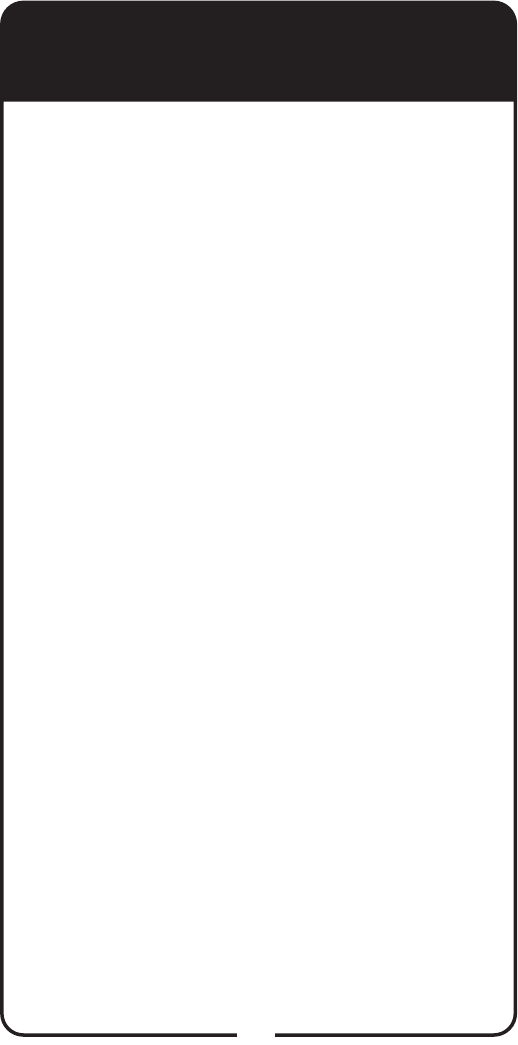
26
Troubleshooting, continued
Your remote control isn’t working.
What to do: Make sure the remote control is in the
correct mode (SAT, TV, DVD, or AUX).
Make sure you are using the correct remote control
(TV1 or TV2) for your locations (applicable to multi-
room receivers only).
Change the batteries as described on page 2.
Your UHF Pro remote control does not work well
from far away.
What to do: Make sure the UHF antenna is
connected to the receiver and not touching anything
else.
Vary the angle of the receiver’s UHF antenna.
Locate the UHF antenna tip away from other
electronics equipment or metal surfaces, even if
separated by wooden shelving.
Move the receiver to different locations. For best
results, place the receiver as high as possible,
above all other equipment in your entertainment
center.
Place the UHF antenna outside the entertainment
center by using a coaxial cable to connect it to the
receiver.
Move any nearby off-air antenna away from the UHF
remote antenna. Do not place an off-air antenna on
your receiver.
Your PIP (Picture-In-Picture) button isn’t
working.
What to do: If your receiver isn’t in Solo PIP (Single
User), press the MODE control on the front panel
(if available) to switch to Solo PIP mode (the amber
light indicates the mode), press SAT on the remote
control and then try the INPUT/Swap PIP button
again.
Verify your receiver has the PIP feature. If your
receiver is not PIP capable, contact DISH Network
about upgrading to a receiver with the PIP feature.
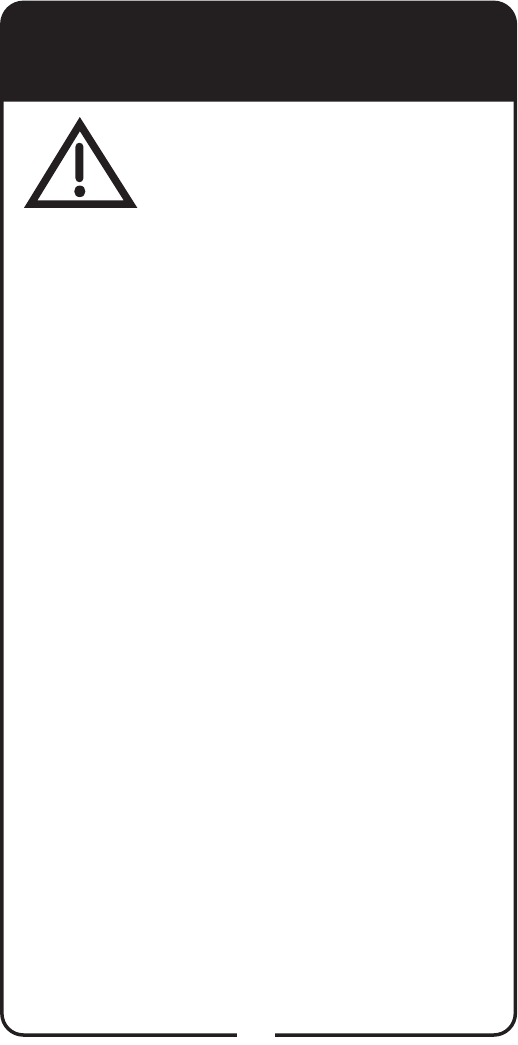
27
Limited Warranty
This Limited Warranty is a legal document. Keep it in a
safe place. Remember to keep your Sales Receipt for
warranty service. We will consider any items you return
without a copy of the Proof of Purchase to be out of
warranty.
This warranty extends only to the original user (“you,” “your”) of the DISH
Network remote control and is limited to the purchase price of the remote
control. EchoStar Technologies L.L.C., formerly known as EchoStar
Technologies Corporation, and its afliated companies (“we,” “our,” “us”)
warrant this remote control against defects in materials or workmanship as
follows.
For one year from the original date of purchase, if we nd the remote control
is defective subject to the limits of this warranty, we will replace the remote at
no charge for parts or labor. We warrant any such work done against defects
in materials or workmanship for the remaining part of the original warranty
period.
This warranty does not cover installation of the DISH Network System;
consumer instruction; physical set up or adjustment of any consumer
electronic equipment; remote control batteries; signal reception problems;
loss of use of the equipment; unused programming charges due to equipment
malfunction; cosmetic damage; damage due to lightning, electrical or
telephone line surges, re, ood, or other acts of Nature; accident; misuse;
abuse; repair or alteration by other than our factory service; negligence;
commercial or institutional use; improper or neglected maintenance;
equipment sold AS IS or WITH ALL FAULTS; equipment removal or
reinstallation; shipping damage if the equipment was not packed and shipped
in the manner we prescribe; nor equipment purchased, serviced, or operated
outside the contiguous United States of America.
REPLACEMENT AS PROVIDED UNDER THIS WARRANTY IS YOUR
EXCLUSIVE REMEDY. WE SHALL NOT BE HELD LIABLE FOR ANY
INCIDENTAL OR CONSEQUENTIAL DAMAGES FOR BREACH OF ANY
EXPRESSED OR IMPLIED WARRANTY ON THIS DEVICE, NOR FOR ANY
INCIDENTAL OR CONSEQUENTIAL DAMAGE RESULTING FROM THE USE
OF, OR INABILITY TO USE, THIS DEVICE. UNDER NO CIRCUMSTANCES
SHALL OUR LIABILITY, IF ANY, EXCEED THE PURCHASE PRICE
PAID FOR THIS DEVICE. EXCEPT TO THE EXTENT PROHIBITED BY
APPLICABLE LAW, ANY IMPLIED WARRANTY OF MERCHANTABILITY OR
FITNESS FOR A PARTICULAR PURPOSE ON THIS DEVICE IS LIMITED IN
DURATION TO THE DURATION OF THIS WARRANTY. WE RESERVE THE
RIGHT TO REFUSE TO HONOR THIS WARRANTY IF WE DETERMINE
ANY OF THE ABOVE EXCEPTIONS TO HAVE CAUSED THIS DEVICE NOT
TO HAVE PERFORMED PROPERLY. THIS WARRANTY SHALL BE VOID IF
ANY FACTORY-APPLIED IDENTIFICATION MARK, INCLUDING BUT NOT
LIMITED TO SERIAL OR CONDITIONAL ACCESS NUMBERS, HAS BEEN
ALTERED OR REMOVED. THIS WARRANTY SHALL ALSO BE VOID IF THE
DEVICE HAS BEEN OPENED BY AN UNAUTHORIZED PERSON (with the
exception of opening the battery cover).
This warranty gives you specic legal rights which may vary from state to
state. Some states do not allow the exclusion or limitations of incidental or
consequential damages, or allow limitations on the duration of an implied
warranty, so those limitations may not apply to you.
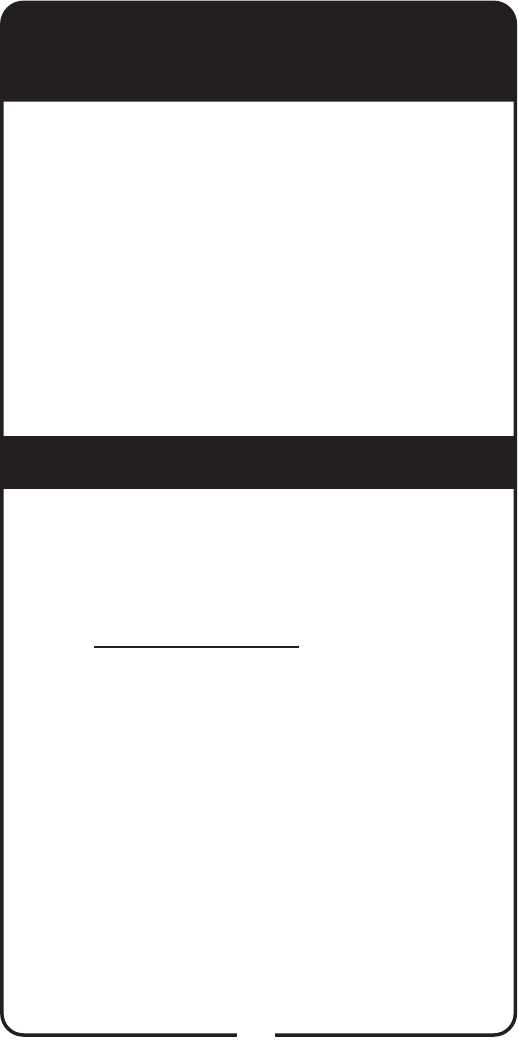
28
Accessory Warranty
An accessory is any DISH Network branded
equipment, displaying the DISH Network logo,
excluding the receiver, Smart Card, cables and
hookups, and non-mechanical components. A one-
year warranty becomes effective upon the activation
of the DISH system or date of purchase, if bought
separately. A proof of purchase is required to verify
the purchase date. If an accessory has an expired
warranty, no exchange will be issued. You may
purchase replacement accessories from DISH
Network or your local retailer.
If You Need Help
1. Review this User Guide.
2. See Troubleshooting on page 24.
3. Visit www.dish.com/chat for 24/7 support.
4. Call the Customer Service Center at
1-800-333-DISH (3474).
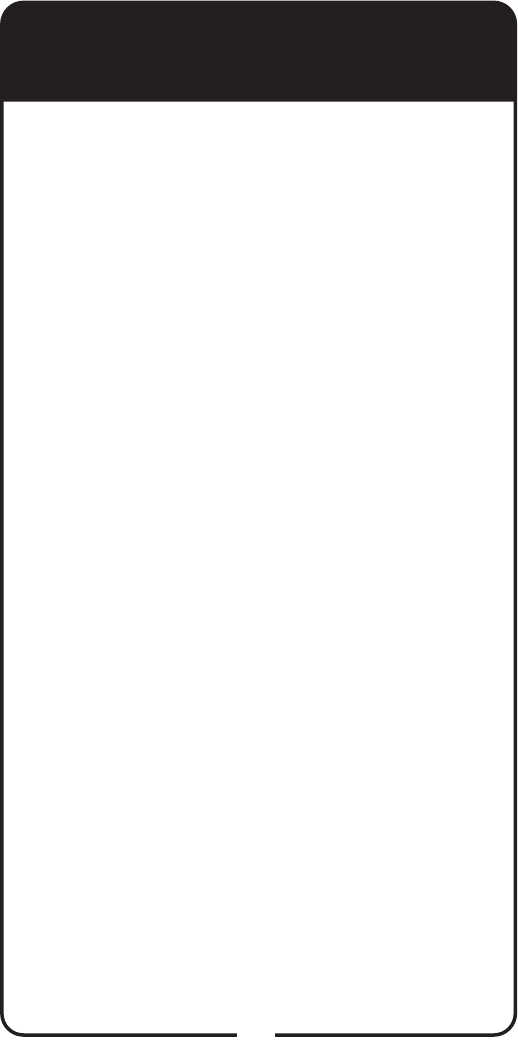
29
Regulatory Factors
EchoStar Technologies Corporation, 94 Inverness
Terrace East, Englewood, CO., (303) 706-4000,
declares that:
This device complies with Part 15 of FCC Rules.
Operation is subject to the following two conditions:
1. This device may not cause harmful
interference,
and
2. This device must accept any interference
received, including interference that may
cause undesired operation.
Changes or modications to this device may void
your authority to operate this equipment.
This equipment has been tested and found to
comply with the limits for a Class B digital device,
pursuant to Part 15 of the FCC Rules. These limits
are designed to provide protection against harmful
interference in a residential installation. This
equipment generates, uses, and can radiate radio
frequency energy and, if not installed and used in
accordance with the instructions, may cause harmful
interference to radio communications. However,
there is no guarantee that interference will not occur
in a particular installation. If this equipment does
cause harmful interference to radio or television
reception, which can be determined by turning the
equipment off and on, the user is encouraged to try
to correct the interference by following one or more
of the following measures:
• Reorient or relocate the receiving antenna.
• Increase the separation between the
equipment and receiver.
• Connect the equipment into an outlet on a
circuit different from that to which the receiver
is connected. Consult the dealer or an
experienced radio/TV technician for help.
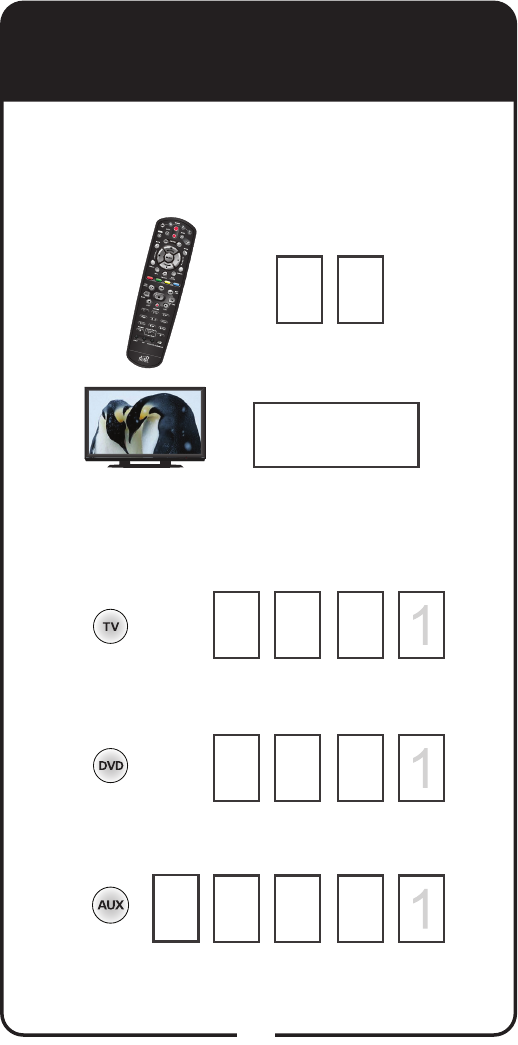
30
Reference Table
Write down your remote address, channel numbers/
inputs, TV, VCR, DVD player, and stereo equipment
codes as you program them for future reference.
If you enter a “1” as the last number of your code,
your remote is in Limited Mode (see page 16 for
more details).
To read out your remote codes, see page 15 for instructions.
(Optional)
(Optional)
Remote Address
Channel or Input for
Cable Programming
TV Code
DVD/VCR/BD Player Code
Auxiliary Equipment Code
(Optional)
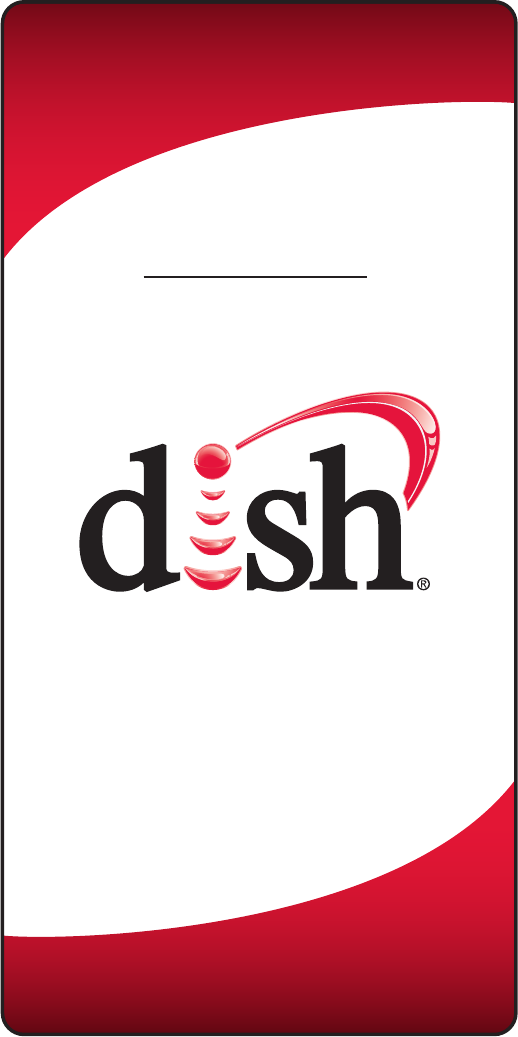
For all your customer needs,
go to www.dish.com/chat or call
the Customer Service center at
1-800-333-DISH (3474)
188891